Wallflower
Photographs by Sabina Rüber
Wallflowers are part of the cabbage family – the brassicas – although you wouldn’t know it with their sweetly scented and brightly coloured spring flowers. Beloved by the Victorians who used them in their colourful bedding schemes, they were also widely grown in Elizabethan times, when they were used as nosegays to mask the stench of the towns and cities. Valuable for their strong colours in early spring, they provide a great foil for tulips in particular, balancing their poker-straight stems with softer, hummocky flowers. They also bridge that gap between the early spring bulbs and summer annuals. Most of the wallflowers mentioned here are forms of the biennial Erysimum cheiri, known as the English wallflower. These grow best from seed, as opposed to perennial wallflowers like ‘Bowles Mauve’ which are propagated from cuttings, and therefore usually bought as plugs or potted plants. Some of the best varieties are the oldest, including ‘Vulcan’, ‘Fire King’ or any with the suffix ‘Bedder’, which harks back to the Victorian bedding schemes they were once part of. ‘Vulcan’ is a delight, with warm-scented flowers whose colour is difficult to pin down – a kind of orange-tinged rusty crimson, dark and velvety. Growing to about 35cm, it is shorter and bushier than other wallflowers, the perfect skirt to a swathe of willowy tulips such as orange ‘Ballerina’ or dusky ‘Ronaldo’. ‘Fire King’ is a lighter, brighter orange, with flowers that literally glow in a border, while ‘Aurora’ is soft pink, a good foil for ‘Orange Emperor’ tulips. Other more subtle shades are available too, including the old-fashioned pale yellow ‘Primrose Bedder’, a dwarf variety growing to about 35cm.
The key to growing wallflowers is in the name: they thrive in stony crevices and find the most unpromising spaces to grow in, preferring a hot, sunny space. Although strictly short-lived perennials, they are treated like biennials, to be sown in late spring or early summer, and planted out in autumn to flower the following spring. They are best sown direct in a nursery seed bed, as they prefer to be in the open air and are prone to fungal infections if grown under cover. Move the seedlings to their final growing positions in autumn.
Back to The Flower Garden main page. To buy a copy of The Flower Garden book click here.



